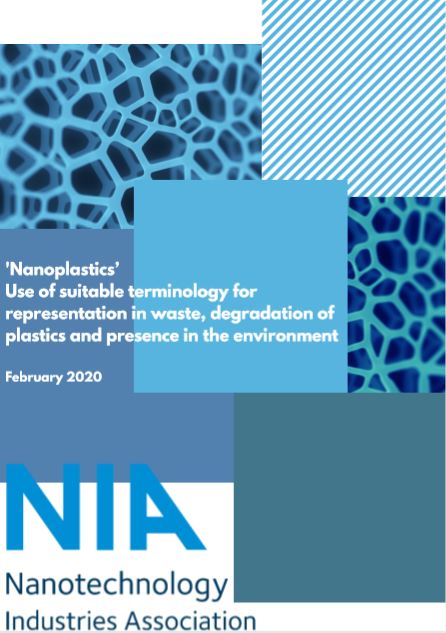 NIA and its members urge caution and clarity when referring to plastics as small particles or fragments.
NIA and its members urge caution and clarity when referring to plastics as small particles or fragments.
‘Nanoplastics’ is a non-specific and ambiguous term, and qualifiers should be considered for accurate presentation to all audiences.
Incidental ‘nanoplastics’, or more specifically incidental plastic nanoscale materials, can be formed by degradation of plastics or from wear.
Manufactured ‘nanoplastics’ (i.e. plastic nanomaterials) are intentionally produced at the nanoscale to allow for specific product characteristics.
The presence of manufactured ‘nanoplastics’ within the environment is expected to be very low as they are incorporated into products (i.e. bound in a matrix).
Plastic waste, and its impact on the environment, is an increasing public concern. Use and inappropriate disposal of plastics has an impact on the environment as, once released into the environment and exposed to factors such as UV-light and mechanical forces, plastic breaks down into smaller sizes that can be dispersed widely both on land and in water. Plastic particles are increasingly demonstrated to be accumulated within ecosystems.
Plastic fragments smaller than 5 mm are now commonly defined as microplastic[i], thus including particles in the nanoscale. To distinguish smaller sized plastic particles, the term ‘nanoplastics’ is often used to describe a size equal to or less than 100 nm (Refs[ii],3). The term ‘nanoplastics’ is increasingly used in scientific publications[iii] and has also been used by the European Commission in funding calls,[iv] and by agencies such as EFSA[v].
Whilst the term ‘nanoplastics’ is grammatically correct to describe plastics at nanoscale lengths (equal to or below 100 nm, following the European Commission recommendation on the term nanomaterial where size is the only deciding factor[vi]), ‘nanoplastics’ is not a helpful or representative term for nanomaterials producers. ‘Nanoplastics’ observed (or predicted, based on identification of microplastics) in the environment are not intentionally manufactured at the nanoscale. Instead they are incidental, or referred to as secondary plastic particles, formed from wear or degradation of larger forms of plastics present in the environment. Current scientific practice cannot yet determine whether a nanoplastic particle found in the environment is intentionally manufactured or is generated by fragmentation from a larger structure.
NIA and its Members highlight that the term ‘nanoplastics’ is a general term and, as such, its use should be qualified to ensure clarity and accuracy. The term ‘nanoplastic’ should be specified by adding a qualifier such as ‘incidental’ or ‘manufactured/intended/engineered’ depending on context. This would distinguish intentionally manufactured ‘nanoplastic’ from incidental ‘nanoplastic’ particles originating from degradation or wear from larger plastics. NIA and its Members believe that the term ‘nanoplastics’ may be confusing for the non-expert, particularly consumers and the distinction is important to ensure understanding and communication from the media and other sources of public information, such as the European Commission, European Observatory for Nanomaterials (EUON) and public agencies.
Use of the term ‘nanoplastics’ in isolation may risk conflating manufactured nanomaterials with all nanoscale plastic particles found in the environment and lead to all materials being viewed in a negative light. Ambiguous and unclear use of the term ‘nanoplastic’ is likely to have a detrimental impact on the global nanomaterials sector and reduce potential benefits from use of nanomaterials within products and processes. To NIA’s current knowledge there are very few intentionally produced nanoplastics, with use largely restricted to scientific research within laboratories.
Whilst the presence of incidental nanoscale plastics in the environment is not caused by the release of intentionally manufactured nanomaterials, the nanotechnology sector can contribute to addressing the nanoscale plastics particles found in the environment. Advances in characterising and understanding the biological interactions of intentionally manufactured nanomaterials can provide models, analytical tools and methods to help address the issue of incidental nanoscale plastic found in the environment.
[i] EHCA Annex XV Restriction report – Proposal for a restriction: Intentionally added microplastics
https://echa.europa.eu/documents/10162/05bd96e3-b969-0a7c-c6d0-441182893720 .
‘microplastic’ means a material consisting of solid polymer- containing particles, to which additives or other substances may have been added, and where ≥ 1% w/w of particles have (i) all dimensions 1nm ≤ x ≤ 5mm, or (ii), for fibres, a length of 3nm ≤ x ≤ 15mm and length to diameter ratio of >3
[ii] Nanoscale Adv., 2019,1, 1055-1061 (https://pubs.rsc.org/en/content/articlelanding/2019/na/c8na00210j#fn1)
[iii] Are We Speaking the Same Language? Recommendations for a Definition and Categorization Framework for Plastic Debris https://pubs.acs.org/doi/10.1021/acs.est.8b05297
[iv] See for example the funding calls for topics SC1-BHC-36-2020 Micro- and nano-plastics in our environment: Understanding exposures and impacts on human health and CE-SC5-29-2020 A common European framework to harmonise procedures for plastics pollution monitoring and assessments which both mention nano plastics.
[vi] Commission Recommendation of 18 October 2011 on the definition of nanomaterial. https://eur-lex.europa.eu/legal-content/EN/TXT/?uri=CELEX:32011H0696



















